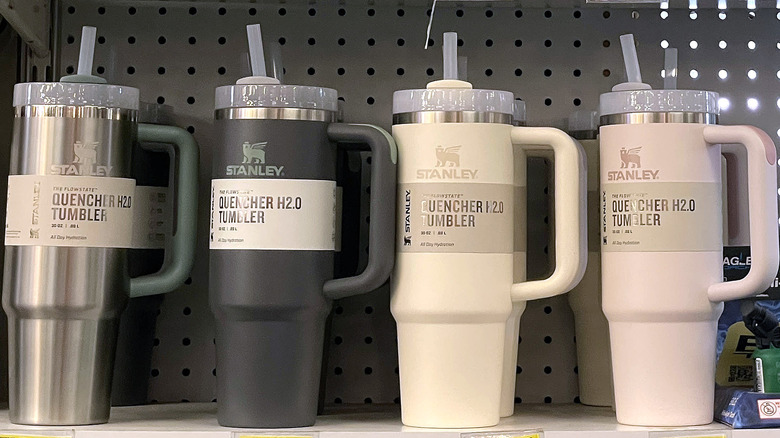Do Stanley Cups Really Contain Lead? Here's What We Know
The viral Stanley tumbler, which boasts over 7.8 billion views on TikTok (#stanleytumblercup), has established itself among TikTok's elite group of influencer-approved products. However, an influx of social media videos focused on lead usage has devoted Stanley collectors worrying about their health. According to a document on the company's website, Stanley tumblers are designed with vacuum insulation technology, and the sealing material used to construct Stanley products does contain lead. As we know, lead exposure can lead to lead poisoning, which can result in, among other complications, high blood pressure, trouble focusing, fatigue, general body pain, and even miscarriage in some circumstances.
While many devoted fans have understandably been concerned about the presence of lead in their beloved Stanley Quenchers, it doesn't appear to be deterring others from adding to their collections. For instance, TikTok user @noahglenncarter posted a video with over 467,000 views in which Stanley fans flock to Target stores to get their hands on a limited edition Valentine's Day release of the classic Quencher. Still, the reception online has been so far-reaching that tumbler competitor Hydro Flask took to Instagram on January 29, 2024, to clarify that its products don't contain lead. "In 2012, we pioneered a new process that sealed our bottles without the use of lead," the company wrote. "We aim for a higher standard."
Despite Stanley's confirmation of lead usage on its official website, rest assured that you might not need to break up with your trendy tumbler just yet — here's why.
Are Stanley cups dangerous?
The fact that Stanley fans have resorted to sharing dupes of the product on social media is a testament to its desirability. Stanley tumblers are so popular on TikTok that they're even considered an emotional support water bottle. While this trend may seem silly to some, a cute water bottle can help you hydrate more, so who are we to judge?
In the wake of the lead scare, videos have cropped up that show people testing their tumblers for lead with at-home tests and even lab-worthy devices. For instance, one Instagram video from @leadsafemama used a simple test kit to determine if the bottom of her Stanley tumbler contained lead. While the results tested positive, viewers should note that the sealing material — and, therefore, the lead — has been exposed. So, although the kit displayed a positive result, this doesn't indicate that drinking from the tumbler will give you lead poisoning, as the exposed sealing piece is on the outside of the cup.
In a similar video, TikTok user @reed00701 uses a professional handheld X-ray fluorescence (XRF) Spectrometer analyzer on the outside of the tumbler. Again, the cup tested positive. However, another individual in the video explains that the results were not considered "high" for a product such as this, though it's unclear whether the second individual is qualified to make such a judgment. In the wake of these tests and the general rising concern, a Stanley spokesperson told Today, "Our engineering and supply chain teams are making progress on innovative, alternative materials for use in the sealing process."
Should you toss out your Stanley tumbler?
For those who remain concerned about the risk of lead exposure, Stanley's online statement provides reassurance that the presence of lead in the sealing material doesn't pose a direct danger to your health. As stated on the brand's site, a stainless steel layer covers the area, "making it inaccessible to consumers." Stanley also confirms that there's no lead on any surface that you or the tumbler's contents may come into direct contact with. If the base cap of your tumbler falls off and reveals the seal, the product becomes eligible for the company's lifetime warranty. Still, some online have been left wondering how much use or damage the tumblers can ideally take before any lead becomes exposed.
Ultimately, the likelihood of experiencing lead poisoning from using your Stanley tumbler is low, as the lead piece is not directly accessible while drinking from an undamaged tumbler. So, you don't need to toss out your extensive Stanley collection. That said, lead poisoning is incredibly toxic to the body and should be taken seriously. If the lead piece has somehow found its way into the main compartment of your tumbler, it's best to stop using the product and consult a health professional if you feel concerned about lead exposure. This especially applies to young children, who are at greater risk of developing health complications from lead poisoning.

